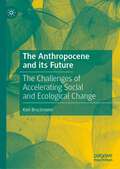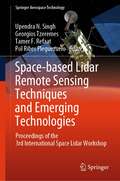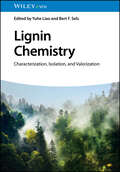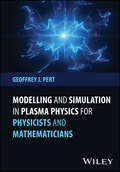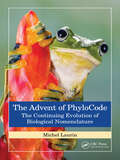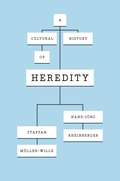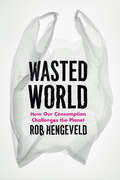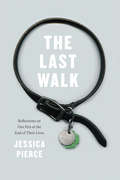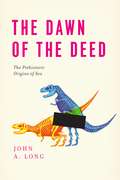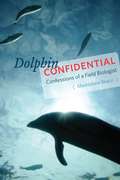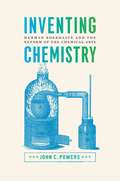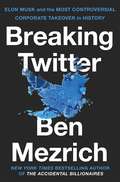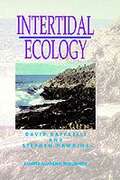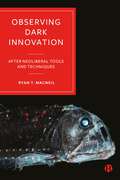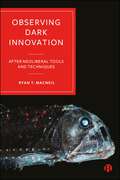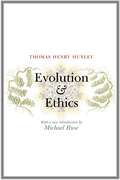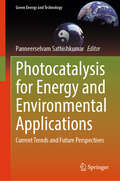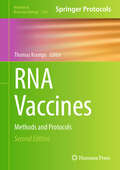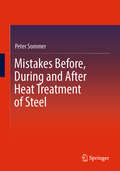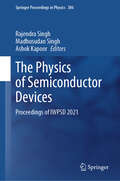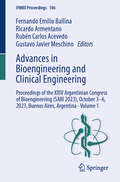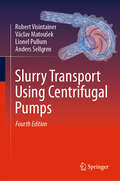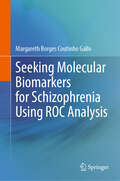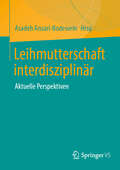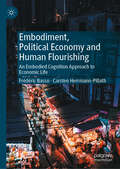- Table View
- List View
The Anthropocene and its Future: The Challenges of Accelerating Social and Ecological Change
by Karl BruckmeierThis book analyses the complex social and ecological processes of the Great Acceleration, the Great Transformation, and sustainable development that shape the future of the global society in the twenty-first century. The first process takes place for a longer time, the second over the past thirty years, with attempts to build a sustainable economy and society in the global policy of sustainable development. The processes and their interaction will be discussed with knowledge from inter- and transdisciplinary transformation research, social and political ecology, and theories of modern society. The guiding theoretical concepts for the social-ecological transformation will be clarified: the concepts of acceleration, transformation, and sustainable development, and the societal and ecological processes they include. To obtain a more detailed picture of the changes in the global social-ecological system, different parts of the global transformation, the digital transformation, the transformation of food systems, and the transformation of modes of living in the social lifeworld are described to show the complex changes in the epoch of the Anthropocene more concretely. The global change processes in society and nature are caused by human forces but are difficult to control through policy and governance. With the interdisciplinary integration of concepts and knowledge, it becomes possible to provide a more detailed picture, of the difficulties to achieve a sustainable future society.
Space-based Lidar Remote Sensing Techniques and Emerging Technologies: Proceedings of the 3rd International Space Lidar Workshop (Springer Aerospace Technology)
by Upendra N. Singh Georgios Tzeremes Tamer F. Refaat Pol Ribes PleguezueloThis book gathers the latest advances, innovations, and applications in the field of space lidar missions, techniques, and technologies, as presented at the 3rd International Workshop on Space-Based Lidar Remote Sensing Techniques and Emerging Technologies (LIDAR), held in Milos Island, Greece, on June 18–23, 2023. It covers highly diverse topics such as space-based lidar techniques and methodologies; challenges experienced in space lidar missions; planning of new space earth observation lidar missions, including monitoring of topography, cryosphere, biomass, greenhouse and trace gases clouds, aerosols; exploration lidars, including entry, decent and precision landing, as well as hazard avoidance for Mars & Lunar landers missions; results and plans for simulations, airborne experiments and demonstrations as precursors for space missions; emerging space lidar technologies, particularly in lasers, optics, electronics and detectors as well as space lidar reliability and influencing factors, such as effects of the space environment. Written by leading scientists and technologists from government agencies, industries and universities, and selected by means of a rigorous international peer-review process, the contributions highlight numerous exciting ideas that will spur novel research directions and foster multidisciplinary collaborations.
Lignin Chemistry: Characterization, Isolation, and Valorization
by Bert F. Sels Yuhe LiaoLignin Chemistry A thorough reference guide to Lignin Chemistry, from inherent structure revealing to transformation into chemicals, fuels, and materials Climate change, driven by rising greenhouse gas emissions, is the defining challenge of our time. Reducing our dependence on non-renewable resources such as fossil fuels will require alternative, more sustainable resources. Lignin, the only widely-occurring, renewable, aromatic bio-polymer in Nature, has a range of application potential in the production of chemicals, fuels, and other industrial materials. Lignin science has become one of the fastest-growing and most significant areas of sustainable chemistry in the world. Lignin Chemistry: Characterization, Isolation, and Valorization presents a systematic, multidisciplinary overview of this cutting-edge field and its current state of research. Beginning with a robust characterization of lignin, the book addresses the isolation and transformation of lignin, as well as the book inspires with a plethora of applications. The result is a critical resource for researchers and professionals in any area of academic or industry where renewable biomass, in particular lignin, has importance. Lignin Chemistry readers will find: Thermochemical and catalytic strategies for lignin conversionDetailed discussion of the valorization of lignin towards biopolymers, nanoparticles, carbon fibers and materials, and hydrogelsAn authorial team with immense and varied research experience Lignin Chemistry is ideal for chemical engineers, catalytic chemists, biochemists, material scientists, and analytical chemists in industry.
Modelling and Simulation in Plasma Physics for Physicists and Mathematicians
by Geoffrey J. PertUnveiling the Secrets of Plasma Physics: A Practical Guide to Computational Simulations Plasma physics focuses on the most abundant state of matter in the universe, corresponding to ionized gas comprising ions and electrons. It can be created artificially and has a huge range of technological applications, from television displays to fusion energy research. Every application of plasma technology requires its own numerical solution to the complex physical and mathematical equations which govern the research field of plasma physics. Modelling and Simulation in Plasma Physics for Physicists and Mathematics offers an introduction to the principles of simulating plasma physics applications. It provides knowledge not only of the fundamental algorithms in computational fluid mechanics, but also their specific role in a plasma physics context. In addition, the book dissects the challenges and advancements, unveiling the delicate balance between accuracy and computational cost. Modelling and Simulation in Plasma Physics for Physicists and Mathematics readers will also find: Cutting-edge computational insights where powerful simulations meet theoretical complexities, providing physicists and mathematicians a gateway to cutting-edge research. An overview of programming language-agnostic code generation and the construction of adaptable models that resonate with the intricate dynamics of plasma physics, ensuring precision in every simulation. Advanced simplification strategies, including time splitting, analytic models, averaged rates, and tabular material, offering scientists and engineers a roadmap to balance computational demands with scientific rigor. Modelling and Simulation in Plasma Physics for Physicists and Mathematics is ideal for plasma physicists, students, and engineers looking to work with plasma technologies.
The Advent of PhyloCode: The Continuing Evolution of Biological Nomenclature
by Michel LaurinBiological nomenclature is an essential tool for storing and retrieving biological information. Yet traditional nomenclature poorly reflects evolutionary theory. Current biological nomenclature is one of the few fields promoting deliberately vague usage of technical terms. A new code based on evolutionary studies and phylogenetic results (the PhyloCode) will be a major milestone in biological nomenclature. Unfortunately, The PhyloCode and the companion volume are highly technical publications intended for practicing systematists. This book will reach a broader readership of those using nomenclature but who remain unaware of its theoretical foundations.Key Features Responds to the biodiversity crisis and the recent implementation of the PhyloCode Summarizes the spectacular progress of phylogenetics which makes it both increasingly easy and crucially important to define precisely taxon names Provides a 300-year historical perspective featuring high-profile characters, such as Linnaeus and Darwin Summarizes for a broad readership a widely scattered, highly technical and underappreciated scientific literature Documents the activities of the International Society for Phylogenetic Nomenclature, a scholarly society in which the author has played a prominent role
A Cultural History of Heredity
by Hans-Jörg Rheinberger Staffan Müller-WilleIt was only around 1800 that heredity began to enter debates among physicians, breeders, and naturalists. Soon thereafter it evolved into one of the most fundamental concepts of biology. Here Staffan Müller-Wille and Hans-Jörg Rheinberger offer a succinct cultural history of the scientific concept of heredity. They outline the dramatic changes the idea has undergone since the early modern period and describe the political and technological developments that brought about these changes. Müller-Wille and Rheinberger begin with an account of premodern theories of generation, showing that these were concerned with the procreation of individuals rather than with hereditary transmission. The authors reveal that when hereditarian thinking first emerged, it did so in a variety of cultural domains, such as politics and law, medicine, natural history, breeding, and anthropology. Müller-Wille and Rheinberger then track theories of heredity from the late nineteenth century—when leading biologists considered it in light of growing societal concerns with race and eugenics—through the rise of classical and molecular genetics in the twentieth century, to today, as researchers apply sophisticated information technologies to understand heredity. What readers come to see from this exquisite history is why it took such a long time for heredity to become a prominent concept in the life sciences and why it gained such overwhelming importance in those sciences and the broader culture over the last two centuries.
Wasted World: How Our Consumption Challenges the Planet
by Rob HengeveldAll systems produce waste as part of a cycle—bacteria, humans, combustion engines, even one as large and complex as a city. To some extent, this waste can be absorbed, processed, or recycled—though never completely. In Wasted World, Rob Hengeveld reveals how a long history of human consumption has left our world drowning in this waste. This is a compelling and urgent work that traces the related histories of population growth and resource consumption. As Hengeveld explains, human life (and population growth) depends not only on mineral resources but also on energy. People first obtained energy from food and later supplemented this with energy from water, wind, and animals as one source after another fell short of our ever-growing needs. Finally, we turned to fossil energy, which generates atmospheric waste that is the key driver of global climate change. The effects of this climate change are already leading to food shortages and social collapse in some parts of the world. Because all of these problems are interconnected, Hengeveld argues strenuously that measures to counter individual problems cannot work. Instead, we need to tackle their common cause—our staggering population growth. While many scientists agree that population growth is one of the most critical issues pressuring the environment, Hengeveld is unique in his insistence on turning our attention to the waste such growth leaves in its wake and to the increasing demands of our global society. A practical look at the sustainability of our planet from the perspective of a biologist whose expertise is in the abundances and distributions of species, Wasted World presents a fascinating picture of the whole process of using, wasting, and exhausting energy and material resources. And by elucidating the complexity of the causes of our current global state, Hengeveld offers us a way forward.
The Last Walk: Reflections on Our Pets at the End of Their Lives (Emersion: Emergent Village Resources For Communities Of Faith Ser.)
by Jessica PierceFrom the moment when we first open our homes—and our hearts—to a new pet, we know that one day we will have to watch this beloved animal age and die. The pain of that eventual separation is the cruel corollary to the love we share with them, and most of us deal with it by simply ignoring its inevitability. With The Last Walk, Jessica Pierce makes a forceful case that our pets, and the love we bear them, deserve better. Drawing on the moving story of the last year of the life of her own treasured dog, Ody, she presents an in-depth exploration of the practical, medical, and moral issues that trouble pet owners confronted with the decline and death of their companion animals. Pierce combines heart-wrenching personal stories, interviews, and scientific research to consider a wide range of questions about animal aging, end-of-life care, and death. She tackles such vexing questions as whether animals are aware of death, whether they're feeling pain, and if and when euthanasia is appropriate. Given what we know and can learn, how should we best honor the lives of our pets, both while they live and after they have left us? The product of a lifetime of loving pets, studying philosophy, and collaborating with scientists at the forefront of the study of animal behavior and cognition, The Last Walk asks—and answers—the toughest questions pet owners face. The result is informative, moving, and consoling in equal parts; no pet lover should miss it.
The Dawn of the Deed: The Prehistoric Origins of Sex
by John A. LongWe all know about the birds and the bees, but what about the ancient placoderm fishes and the dinosaurs? The history of sex is as old as life itself—and as complicated and mysterious. And despite centuries of study there is always more to know. In 2008, paleontologist John A. Long and a team of researchers revealed their discovery of a placoderm fish fossil, known as “the mother fish,” which at 380 million years old revealed the oldest vertebrate embryo—the earliest known example of internal fertilization. As Long explains, this find led to the reexamination of countless fish fossils and the discovery of previously undetected embryos. As a result, placoderms are now considered to be the first species to have had intimate sexual reproduction or sex as we know it—sort of. Inspired by this incredible find, Long began a quest to uncover the paleontological and evolutionary history of copulation and insemination. In The Dawn of the Deed, he takes readers on an entertaining and lively tour through the sex lives of ancient fish and exposes the unusual mating habits of arthropods, tortoises, and even a well-endowed (16.5 inches!) Argentine Duck. Long discusses these significant discoveries alongside what we know about reproductive biology and evolutionary theory, using the fossil record to provide a provocative account of prehistoric sex. The Dawn of the Deed also explores fascinating revelations about animal reproduction, from homosexual penguins to monogamous seahorses to the difficulties of dinosaur romance and how sexual organs in ancient shark-like fishes actually relate to our own sexual anatomy. The Dawn of the Deed is Long’s own story of what it’s like to be a part of a discovery that rewrites evolutionary history as well as an absolutely rollicking guide to sex throughout the ages in the animal kingdom. It’s natural history with a naughty wink.
Dolphin Confidential: Confessions of a Field Biologist
by Maddalena BearziWho hasn’t fantasized about the unique thrill of working among charismatic and clever dolphins in the wild? Now we no longer have to rely solely on our imaginations . With Dolphin Confidential, Maddalena Bearzi invites all of us shore-bound dreamers to join her and travel alongside the dolphins. In this fascinating account, she takes us inside the world of a marine scientist and offers a firsthand understanding of marine mammal behavior, as well as the frustrations, delights, and creativity that make up dolphin research. In this intimate narrative, Bearzi recounts her experiences at sea, tracing her own evolution as a woman and a scientist from her earliest travails to her transformation into an advocate for conservation and dolphin protection. These compelling, in-depth descriptions of her fieldwork also present a captivating look into dolphin social behavior and intelligence. The central part of the book is devoted to the metropolitan bottlenose dolphins of California, as Bearzi draws on her extensive experience to offer insights into the daily lives of these creatures—as well as the difficulties involved in collecting the data that transforms hunches into hypotheses and eventually scientific facts. The book closes by addressing the critical environmental and conservation problems facing these magnificent, socially complex, highly intelligent, and emotional beings. An honest, down-to-earth analysis of what it means to be a marine biologist in the field today, Dolphin Confidential offers an entertaining, refreshingly candid, and always informative description of life among the dolphins.
Inventing Chemistry: Herman Boerhaave and the Reform of the Chemical Arts (Synthesis)
by John C. PowersIn Inventing Chemistry, historian John C. Powers turns his attention to Herman Boerhaave (1668–1738), a Dutch medical and chemical professor whose work reached a wide, educated audience and became the template for chemical knowledge in the eighteenth century. The primary focus of this study is Boerhaave’s educational philosophy, and Powers traces its development from Boerhaave’s early days as a student in Leiden through his publication of the Elementa chemiae in 1732. Powers reveals how Boerhaave restructured and reinterpreted various practices from diverse chemical traditions (including craft chemistry, Paracelsian medical chemistry, and alchemy), shaping them into a chemical course that conformed to the pedagogical and philosophical norms of Leiden University’s medical faculty. In doing so, Boerhaave gave his chemistry a coherent organizational structure and philosophical foundation and thus transformed an artisanal practice into an academic discipline. Inventing Chemistry is essential reading for historians of chemistry, medicine, and academic life.
Breaking Twitter: Elon Musk and the Most Controversial Corporate Takeover in History
by Ben Mezrich‘An excitable, high-octane account’ – IndependentIn October 2022, Elon Musk marched through Twitter’s front doors after buying the digital giant for $44 billion. His takeover came with the promise of fundamental change, but nothing could prepare the company for the chaos to come – brutal mass firings, an exodus of advertisers and ‘blue-tick’ celebrities and a vicious battle for control.With unique access to Twitter insiders and Musk’s confidants, this is the astonishing story from all sides. Why did Elon overhaul Twitter’s blue-tick system, and how did it lead to the near-collapse of the company’s revenue? Will Twitter – now X – survive? How has the constant negative press coverage affected Elon?With a wealth of hidden details, Breaking Twitter gives ringside seats to one of the most dramatic and compelling business stories of our time.‘Mezrich’s books are the sort of engrossing reads you pick up in the airport then find the blockbuster film on the plane’ – Evening Standard
Intertidal Ecology
by Stephen Hawkins D. Raffaelli D. RafaelliThe seashore has long been the subject of fascination and study - the Ancient Greek scholar Aristotle made observations and wrote about Mediterranean sea urchins. The considerable knowledge of what to eat and where it could be found has been passed down since prehistoric times by oral tradition in many societies - in Britain it is still unwise to eat shellfish in months without an 'r' in them. Over the last three hundred years or so we have seen the formalization of science and this of course has touched intertidal ecology. Linnaeus classified specimens collected from the seashore and many common species (Patella vulgata L. , Mytilus edulis L. , Littorina littorea (L. )) bear his imprint because he formally described, named and catalogued them. Early natural historians described zonation patterns in the first part of the 19th century (Audouin and Milne-Edwards, 1832), and the Victorians became avid admirers and collectors of shore animals and plants with the advent of the new fashion of seaside holidays (Gosse, 1856; Kingsley, 1856). As science became professionalized towards the end of the century, marine biologists took advantage of low tides to gain easy access to marine life for taxonomic work and classical studies of functional morphology.
Observing Dark Innovation: After Neoliberal Tools and Techniques
by Ryan T. MacNeilAvailable open access digitally under CC-BY-NC-ND licence. Why does scholarship on innovation fixate on certain classes of technology? Could our research tools and techniques be concealing as much as they reveal? Ryan T. MacNeil shows how the common instrumentalities of innovation research carry neoliberal market biases. He calls for critical scholars to examine how we observe and understand innovation, offering ways forward to deconstruct and reform disciplinary conventions. This book makes a valuable contribution to critical management and science and technology studies by shedding light on the ‘dark matter’ of innovation. This will be an important resource for scholars and practitioners interested in disruptive ideas about innovation.
Observing Dark Innovation: After Neoliberal Tools and Techniques
by Ryan T. MacNeilAvailable open access digitally under CC-BY-NC-ND licence. Why does scholarship on innovation fixate on certain classes of technology? Could our research tools and techniques be concealing as much as they reveal? Ryan T. MacNeil shows how the common instrumentalities of innovation research carry neoliberal market biases. He calls for critical scholars to examine how we observe and understand innovation, offering ways forward to deconstruct and reform disciplinary conventions. This book makes a valuable contribution to critical management and science and technology studies by shedding light on the ‘dark matter’ of innovation. This will be an important resource for scholars and practitioners interested in disruptive ideas about innovation.
Evolution and Ethics: And Other Essays
by Thomas Henry HuxleyHuxley's classic lecture on evolution, human nature, and the way to true happinessThomas Henry Huxley (1825–1895) was one of the most prominent evolutionists of the late nineteenth century. A close companion of Charles Darwin, Huxley developed a reputation as "Darwin's Bulldog" for his relentless defense of evolutionary theory. Huxley was also an ardent supporter of social reform, particularly in his call for quality education at all levels. Evolution and Ethics, widely considered to be his greatest lecture, distilled a lifetime's wisdom and sensitive understanding of the nature and needs of humankind. Arguing that the human psyche is at war with itself, that humans are alienated in the cosmos, and that moral societies are necessarily in conflict with the natural conditions of their existence, Huxley nevertheless saw moral dictates as the key to future human happiness and success. This beautiful edition features an introduction by renowned historian and philosopher of biology Michael Ruse, placing Huxley's lecture in its original context while showing its even deeper relevance for our own time.
Photocatalysis for Energy and Environmental Applications: Current Trends and Future Perspectives (Green Energy and Technology)
by Panneerselvam SathishkumarThis book presents the existing photocatalytic reactor design and the future developments and the progress needed for both solar light-driven hydrogen generation and environmental purification. The chapters discuss the renewable and commercial aspects of translucent polymer-linked heterojunction nanocomposites as visible light-responsive photocatalysts. Relevant to these areas, the field of growing interest in black-TiO2, perovskites, MXenes and their numerous applications are presented. The framework, structural features and the need of mesocrystals for solar light-driven photocatalysis are also included. The book also discusses the additional features of green chemistry-based synthesis of nanomaterials in order to reduce any secondary pollution that may be released in the environment due to unsafe disposal of solvents. In addition, the importance of bismuth-based nanophotocatalysts towards energy and environmental applications and their future development as alternative photocatalysts for the prevailing nanomaterials are presented. The book also touches upon the idea to generate green fuel hydrogen through photocatalytic and photoelectrochemical techniques. Overall the book highlights contemporary developments in the last decade, the future perspectives of photocatalysis and its application towards energy and environment.
RNA Vaccines: Methods and Protocols (Methods in Molecular Biology #2786)
by Thomas KrampsThis second edition volume expands on the previous edition with discussions of the latest technology and advancements in the development of RNA vaccines and proposed solutions on how to tackle currently unmet medical needs. The chapters in this book are organized into four parts and cover topics such as replication and non-replicating RNA vectors, formulation and delivery of RNA vaccines, and clinical and nonclinical development of RNA vaccines. Written in the highly successful Methods in Molecular Biology series format, chapters include introductions to their respective topics, lists of the necessary materials and reagents, step-by-step, readily reproducible laboratory protocols, and tips on troubleshooting and avoiding known pitfalls.Practical and comprehensive, RNA Vaccines: Methods and Protocols, Second Edition is a valuable resource for any researcher interested in learning more about this important and developing field.
Mistakes Before, During and After Heat Treatment of Steel
by Peter SommerA multitude of steel components undergo heat treatment to alter their properties. This practice-oriented book provides a vivid overview of the various influencing factors in the lifecycle of such products, from design to deployment. Through numerous examples, it illustrates potential sources of errors associated with heat treatment and how to avoid them. Drawing on decades of experience in the field of technical failure analysis, the author offers valuable guidance for both students and practitioners.
The Physics of Semiconductor Devices: Proceedings of IWPSD 2021 (Springer Proceedings in Physics #306)
by Rajendra Singh Madhusudan Singh Ashok KapoorThis book includes proceedings of the 21st International Workshop on Physics of Semiconductor Devices. The workshop is jointly organized by the Indian Institute of Technology, Delhi, and Solid State Physics Laboratory, Delhi, in collaboration with the Society for Semiconductor Devices and Semiconductor Society of India. This book disseminates the current knowledge of semiconductor physics and its applications across the scientific community. It is based on a biennial workshop that provides the participating research groups with a stimulating platform for interaction and collaboration with colleagues from the same scientific community. The book discusses the latest developments in III-nitrides; materials and devices, compound semiconductors, VLSI technology, optoelectronics, sensors, photovoltaics, crystal growth, epitaxy, and characterization, graphene, and other 2D materials and organic semiconductors. The research articles included in this book are contributed by various eminent scientists from all over the world. The book serves as a reference resource for researchers and practitioners in academia and industry.
Advances in Bioengineering and Clinical Engineering: Proceedings of the XXIV Argentinian Congress of Bioengineering (SABI 2023), October 3–6, 2023, Buenos Aires, Argentina - Volume 1 (IFMBE Proceedings #106)
by Ricardo Armentano Fernando Emilio Ballina Rubén Carlos Acevedo Gustavo Javier MeschinoThis book offers a timely snapshot of research, technologies and best practices in the broad area of bioengineering and clinical engineering. It reports on advances in biomechanics, biomedical image processing, biomaterials and tissue engineering. Further, it covers applications of artificial intelligence in biology and medicine, and instrumentation. Gathering the first volume of the proceedings of the XXIV Argentinian Congress of Bioengineering (SABI 2023), held on October 3–6, 2023, in Buenos Aires, Argentina - and organised by the Sociedad Argentina de Bioingeniería, this book provides an extensive source of information for both researchers and professionals in biomedical and clinical engineering.
Slurry Transport Using Centrifugal Pumps
by Václav Matoušek Robert Visintainer Lionel Pullum Anders SellgrenThis book is based on the industry leading short course of the same name hosted by the GIW Industries Hydraulic Laboratory and founded by Dr. Roland Clift and Graeme Addie, who together with Dr. Ken Wilson continued its development and authored the first edition of this textbook. This fourth edition has been extensively updated by the international team of engineers and authors who inherited this legacy and continue its development to the present day. Focusing on the hydraulic design of slurry pipelines, the pumps that power them, and the interactions between pumps and systems, it retains the classroom tested balance of theoretical development and practical engineering which have made it a slurry transport classic. The topics covered are important to slurry system engineers for the optimization of new designs, as well as the operators of existing systems, who may need to calculate and plan for changing conditions from day to day.Updates to the fourth edition include:· Careful formulation of the theoretical concepts, providing greater clarity of slurry flow dynamics, including a new chapter on the principles and characterization of slurry flows.· Expansion of the 4-Component Models for settling slurry pipeline flow and pump solids effect, based on an extensive series of full-sized tests.· An expanded treatment of complex slurries, including a broader discussion of non-Newtonian fluids and their interaction with coarse particles.· A new chapter on test methods, presenting an overview of slurry system instrumentation, moderntechniques for characterizing slurry rheology, and practical advice for planning and executing a slurry test.· An overview of advances in the computational modeling of slurries, including an in-depth parametric study of slurry pump wear and operating cost.The authors highlight methods for achieving energy efficiency, which are crucial to the effective use of scarce resources, given the foundational role of slurry transport systems in the energy intensive industries of mining and dredging. Key concepts are supported with case studies and worked examples.Slurry Transport Using Centrifugal Pumps, fourth edition, is both methodical and in-depth. It is ideal as a teaching tool for classroom or self-directed learning domains, and valuable as a design guide for engineer practitioners at all experience levels.
Seeking Molecular Biomarkers for Schizophrenia Using ROC Analysis
by Margareth Borges Coutinho GalloSchizophrenia Spectrum Disorders (SSD) manifest multidimensionally, presenting a syndromic nature with several symptomatic domains. These are driven by dynamic systemic biological changes that unfold over the course of the disease. Thus far, the diagnosis is solely based on symptoms, which may be rather subjective, moving research toward the search for SSD biomarkers. This book presents a summary of the main hypotheses that have evolved over time to explain the pathophysiology of SSD and that have driven the discovery of associated biomarkers: neurotrophic, neurotransmitter, neuroendocrine, immune-inflammatory, nitrosative/oxidative stress, metabolic, and gut microbiota-brain axis. The book shows the most relevant research carried out in the last twelve years to develop predictive, diagnostic, theranostic or transdiagnostic models based on these biomarkers using the receiver operating characteristic curve (ROC) analysis. Chapters also discuss how the literature has addressed the development and/or addition of new discriminatory biomarkers to achieve robust and successful results. The book is rounded out with a step-by-step explanation on how to work on the MetaboAnalyst platform, including the meaning of the chosen statistics and how to interpret them in the results obtained. This book is a useful resource for students and scientists involved in the discovery of biomarkers for psychiatric disorders and other diseases.
Leihmutterschaft interdisziplinär: Aktuelle Perspektiven
by Asadeh Ansari-BodeweinDer vorliegende Band enthält eine Sammlung von Aufsätzen zum Thema Leihmutterschaft aus Blickrichtungen verschiedener Disziplinen, die allesamt jeweils an den aktuellen Forschungsstand anknüpfen. Das Buch wendet sich an Interessierte aller Fächer, die sich mit der kontrovers diskutierten Frage nach einer Liberalisierung von Leihmutterschaftsmodellen befassen und gibt dabei einen Einblick in die Grundlagen der Diskussion in den relevanten Fächern Philosophie, Psychologie, Soziologie, Rechtswissenschaft und Medizin.
Embodiment, Political Economy and Human Flourishing: An Embodied Cognition Approach to Economic Life
by Carsten Herrmann-Pillath Frédéric BassoThis book presents embodied economics as a foundational alternative to behavioral economics and other projects integrating economics and psychology inspired by the computational paradigm. The 20th century witnessed the disembodiment of economic models through the intensification of mathematization and formal abstraction in economics. Even proponents of an embodied approach to cognition, such as Hayek, paradoxically championed the abstract market order as a disembodied superhuman intelligence. In the wake of groundbreaking perspectives in cognitive and social sciences, which have helped to rethink the fundamental building blocks of economics, agency and institutions, this title takes a radical turn towards embodiment. Reinstating economics as political economy, embodied economics motivates a critique of capitalism based on the analysis of disembodiment through abstraction and reactivates key critical insights into the anthropology put forward by the young Marx about contemporary economics and its conceptualizations of money, property, and labor. Based on this analysis, the authors envision a concrete utopia for an economic order centered on human dignity and care for life on Earth. This book contributes to recent discussions about behavioral, experimental and neuroeconomics and addresses a transdisciplinary audience in the social and behavioral sciences, philosophy, and the humanities.
